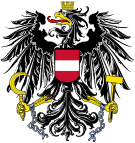
Back نظام النمسا السياسي Arabic Avstriyanın dövlət quruluşu Azerbaijani Австрияның дәүләт ҡоролошо Bashkir Палітыка Аўстрыі Byelorussian Държавно устройство на Австрия Bulgarian অস্ট্রিয়া#রাজনীতি Bengali/Bangla Politický systém Rakouska Czech Østrigs politik Danish Politisches System Österreichs German Πολιτική της Αυστρίας Greek
| This article is part of a series on the |
| Politics of Austria |
|---|
 |
Politics in Austria reflects the dynamics of competition among multiple political parties, which led to the formation of a Conservative-Green coalition government for the first time in January 2020, following the snap elections of 29 September 2019, and the election of a former Green Party leader to the presidency in 2016.
Austrian politics takes place within the constitutional framework of a federal semi-presidential republic, with a President (Bundespräsident) serving as head of state and a Chancellor (Bundeskanzler) as head of government. Governments, both local and federal, exercise executive power. Federal legislative power is vested both in the Federal Government and in the two chambers of Parliament; the National Council (Nationalrat) and the Federal Council (Bundesrat). The Judiciary of Austria is independent of the executive and legislative branches of government.
Following the end the Second World War and re-establishment of Austria as a sovereign state, the conservative Austrian People's Party (ÖVP) and the centre-left Social Democratic Party of Austria (SPÖ) dominated politics and public life for decades, with only one additional party—the FPÖ—playing a significant role at the national level. More recently, the pattern of two-party dominance withered with the rise of newer parties, such as the Greens and the NEOS.
The ethnically and culturally heterogeneous nation-state of Austria is one of the many remnant states of Austria-Hungary, a vast multinational empire that ceased to exist in 1918. The Austrian Republic was preceded by a constitutional monarchy, whose legislative body was elected by, as The New York Times put it, "quasi-universal (male) suffrage" for the first time in 1897.[1]
Austria's first attempt at republican governance after the fall of the monarchy in 1918 was severely hampered by the crippling economic burden of war reparations required by the victorious Allies. Austria's First Republic (1918–1938) made some pioneering reforms in the 1920s, particularly in Vienna, that served as models for the social-welfare states of post-World War I Europe. However, the Republic gradually developed into the Austrofascist dictatorship between 1933 and 1934 under Chancellor Engelbert Dollfuss, who was assassinated by Nazi party agents in 1934. The First Republic ended with the Anschluss (annexation) to Nazi Germany in 1938. Following the defeat of the German Reich in 1945 Austria resumed its republican government, after it fully regained its independence from the occupying Allied Powers. Austria's political system after re-establishment of democracy and self-determination is referred to as the Second Republic.
The beginning of the 21st century marked, for Austria, a half-century of a stable government under a constitutional federal republican system. It is governed according to the principles of representative democracy and the rule of law. The constitutional framework of the politics of Austria and the marrow of the constitution's practical implementation are widely agreed[by whom?] to be robust and adequately[quantify] conducive to peaceful change.
Austria was the 35th most electoral democratic country in the world in 2023 according to the V-Dem Democracy indices.[2]
- ^ de Wolf, Bradford Colt (3 April 1897). IN AUSTRIA'S PARLIAMENT, There Is A Socialist Group. New York Times. Retrieved 21 May 2010.
- ^ V-Dem Institute (2023). "The V-Dem Dataset". Retrieved 14 October 2023.


